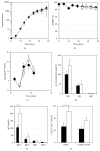Human CD38hiCD138⁺ plasma cells can be generated in vitro from CD40-activated switched-memory B lymphocytes
- PMID: 25759831
- PMCID: PMC4352507
- DOI: 10.1155/2014/635108
Human CD38hiCD138⁺ plasma cells can be generated in vitro from CD40-activated switched-memory B lymphocytes
Abstract
B lymphocyte differentiation into long-lived plasma cells is the keystone event for the production of long-term protective antibodies. CD40-CD154 and CD27-CD70 interactions are involved in human B lymphocyte differentiation into CD38(hi)CD138(+) cells in vivo as well as in vitro. In this study, we have compared these interactions in their capacity to drive switched-memory B lymphocytes differentiation into CD38(hi)CD138(+) plasma cells. The targeted B lymphocytes were isolated from human peripheral blood, expanded for 19 days, and then submitted to CD70 or CD154 interactions for 14 days. The expanded B lymphocytes were constitutively expressing CD39, whereas CD31's expression was noticed only following the in vitro differentiation step (day 5) and was exclusively present on the CD38(hi) cell population. Furthermore, the generated CD38(hi)CD138(+) cells showed a higher proportion of CD31(+) cells than the CD38(hi)CD138(-) cells. Besides, analyses done with human blood and bone marrow plasma cells showed that in vivo and de novo generated CD38(hi)CD138(+) cells have a similar CD31 expression profile but are distinct according to their reduced CD39 expression level. Overall, we have evidences that in vitro generated plasma cells are heterogeneous and appear as CD39(+) precursors to the ones present in bone marrow niches.
Figures






Similar articles
-
Bone Marrow Mesenchymal Stem Cells Enhance the Differentiation of Human Switched Memory B Lymphocytes into Plasma Cells in Serum-Free Medium.J Immunol Res. 2016;2016:7801781. doi: 10.1155/2016/7801781. Epub 2016 Oct 31. J Immunol Res. 2016. PMID: 27872867 Free PMC article.
-
IL-10 production in murine IgM+ CD138hi cells is driven by Blimp-1 and downregulated in class-switched cells.Eur J Immunol. 2017 Mar;47(3):493-503. doi: 10.1002/eji.201646549. Epub 2017 Jan 10. Eur J Immunol. 2017. PMID: 28012163
-
CD27/CD70 interaction augments IgE secretion by promoting the differentiation of memory B cells into plasma cells.J Immunol. 1998 Dec 15;161(12):6496-502. J Immunol. 1998. PMID: 9862673
-
Tuning of CD40-CD154 interactions in human B-lymphocyte activation: a broad array of in vitro models for a complex in vivo situation.Arch Immunol Ther Exp (Warsz). 2011 Feb;59(1):25-40. doi: 10.1007/s00005-010-0108-8. Epub 2011 Jan 14. Arch Immunol Ther Exp (Warsz). 2011. PMID: 21234809 Review.
-
Regulation of B-cell commitment to plasma cells or to memory B cells.Semin Immunol. 1997 Aug;9(4):235-40. doi: 10.1006/smim.1997.0080. Semin Immunol. 1997. PMID: 9237929 Review.
Cited by
-
Stage-Specific Non-Coding RNA Expression Patterns during In Vitro Human B Cell Differentiation into Antibody Secreting Plasma Cells.Noncoding RNA. 2022 Feb 5;8(1):15. doi: 10.3390/ncrna8010015. Noncoding RNA. 2022. PMID: 35202088 Free PMC article.
-
The Tumor Immune Microenvironment Architecture Correlates with Risk of Recurrence in Head and Neck Squamous Cell Carcinoma.Cancer Res. 2023 Dec 1;83(23):3886-3900. doi: 10.1158/0008-5472.CAN-23-0379. Cancer Res. 2023. PMID: 37602821 Free PMC article.
-
Altered frequencies of memory B cells in new-onset systemic lupus erythematosus patients.Clin Rheumatol. 2018 Jan;37(1):205-212. doi: 10.1007/s10067-017-3877-1. Epub 2017 Oct 25. Clin Rheumatol. 2018. PMID: 29067587
-
Bone Marrow Mesenchymal Stem Cells Enhance the Differentiation of Human Switched Memory B Lymphocytes into Plasma Cells in Serum-Free Medium.J Immunol Res. 2016;2016:7801781. doi: 10.1155/2016/7801781. Epub 2016 Oct 31. J Immunol Res. 2016. PMID: 27872867 Free PMC article.
-
GPR55 in B cells limits atherosclerosis development and regulates plasma cell maturation.Nat Cardiovasc Res. 2022 Nov;1:1056-1071. doi: 10.1038/s44161-022-00155-0. Epub 2022 Nov 11. Nat Cardiovasc Res. 2022. PMID: 36523570 Free PMC article.
References
-
- Kawano M. M., Mihara K., Huang N., Tsujimoto T., Kuramoto A. Differentiation of early plasma cells on bone marrow stromal cells requires interleukin-6 for escaping from apoptosis. Blood. 1995;85(2):487–494. - PubMed
MeSH terms
Substances
LinkOut - more resources
Full Text Sources
Other Literature Sources
Research Materials

